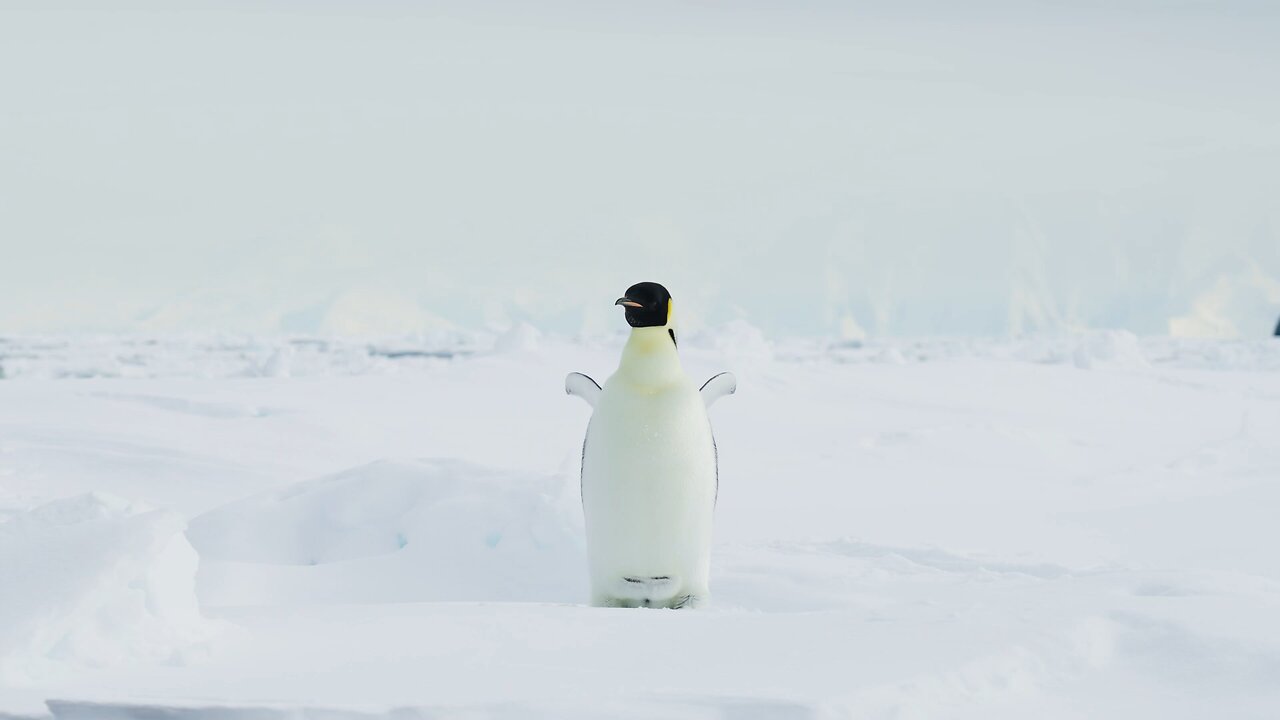Premium Only Content

Emperor penguin, Coulman Island, Antarctica 4K
Emperor penguin, Coulman Island, Antarctica 4K
Blagoj Klincharski
28
Likes
804
Views
22 Feb
2023
The emperor penguin (Aptenodytes forsteri) is the tallest and heaviest of all living penguin species and is endemic to Antarctica. The male and female are similar in plumage and size, reaching 100 cm (39 in) in length and weighing from 22 to 45 kg (49 to 99 lb). Feathers of the head and back are black and sharply delineated from the white belly, pale-yellow breast and bright-yellow ear patches.
Like all penguins, it is flightless, with a streamlined body, and wings stiffened and flattened into flippers for a marine habitat. Its diet consists primarily of fish, but also includes crustaceans, such as krill, and cephalopods, such as squid. While hunting, the species can remain submerged around 20 minutes, diving to a depth of 535 m (1,755 ft). It has several adaptations to facilitate this, including an unusually structured haemoglobin to allow it to function at low oxygen levels, solid bones to reduce barotrauma, and the ability to reduce its metabolism and shut down non-essential organ functions.
The only penguin species that breeds during the Antarctic winter, emperor penguins trek 50–120 km (31–75 mi) over the ice to breeding colonies which can contain up to several thousand individuals. The female lays a single egg, which is incubated for just over two months by the male while the female returns to the sea to feed; parents subsequently take turns foraging at sea and caring for their chick in the colony. The lifespan is typically 20 years in the wild, although observations suggest that some individuals may live to 50 years of age.
Coulman Island is an ice-covered island in the Ross Sea, located 14 km (8.7 mi) southeast of Cape Jones, Victoria Land, Antarctica. It is 33.3 km (20.7 mi) long, 14.8 km (9.2 mi) wide and 6,562 ft (2,000 m) in elevation. Emperor penguins inhabit this island. It was discovered in 1841 by Sir James Clark Ross who named it for his father-in-law, Thomas Coulman. A notable landmark of this island is Cape Anne, the south-easternmost point of the island, so named by Sir James Clark Ross for his wife. Cape Wadworth is the northernmost point of the island.
The island is composed of several overlapping shield volcanoes that form part of the Hallett Volcanic Province of the McMurdo Volcanic Group. A 5 km (3.1 mi) wide and 700 m (2,300 ft) deep caldera called the Hawkes Heights can be found on the south end of the island.
-
 1:05:28
1:05:28
Man in America
12 hours agoTREASON? Obama, Hillary, and Soros in the New World Order Agenda EXPOSED w/ Mel K
76.1K57 -
 2:22:46
2:22:46
The Connect: With Johnny Mitchell
12 hours ago $3.54 earnedOne Man's Mission To Stop Human Trafficking: How A Billionaire Mercenary Saved Hundreds Of Children
17.7K11 -
 2:35:13
2:35:13
Tundra Tactical
8 hours ago $6.99 earned🔫 California Ammo Win, Sig Sauer P320 Controversy, Meme Review & Would You Rather! 🎉🔥
33.4K5 -
 16:24
16:24
Forrest Galante
5 hours ago6 Deadliest Man Eaters to Ever Exist
23.5K3 -
 10:14
10:14
MattMorseTV
10 hours ago $13.77 earnedThe EU is in HOT WATER.
89.9K53 -
 LIVE
LIVE
The Rabble Wrangler
1 day agoPUBG with The Best in the West!
623 watching -
 3:57:19
3:57:19
EvilT4000
8 hours ago $4.98 earnedSaturday.....🟢For energy and focus click my Dubby link!
30.6K3 -
 3:02:55
3:02:55
SlingerGames
5 hours agoSpartan Night - Halo and More | Creator for @SELFMADEGGS
20.2K -
 3:57:49
3:57:49
Mally_Mouse
11 hours agoSpicy Saturday!! - 10k CELEBRATION! - Let's Play: Labyrinthine
34.4K1 -
 37:09
37:09
The Mel K Show
11 hours agoMel K & Dr. Kirk Moore | A Doctor’s Oath: Doing What is Right No Matter the Cost | 7-26-25
34.3K15